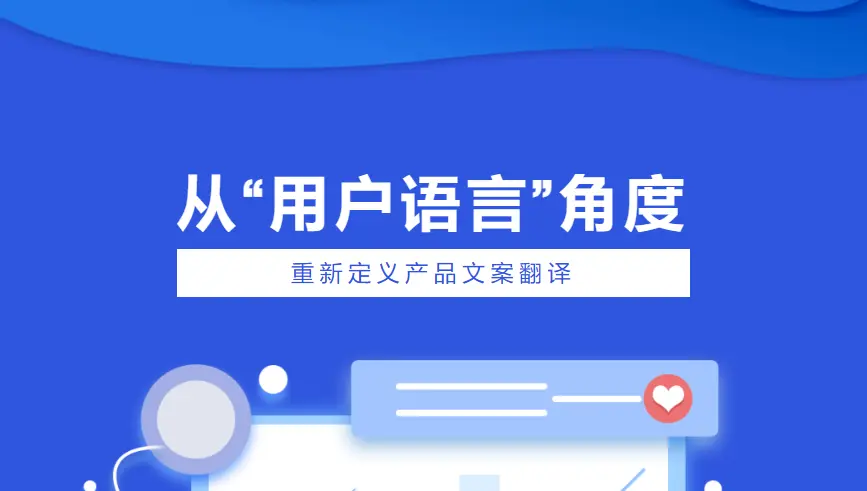Redefining Product copywriting Translation Through the Perspective of "User Language"
In our previous article, we explored the synergy between design and translation. Some readers shared that their marketing teams crafted compelling product copywriting, highlighting unique selling points, which was then "accurately" translated by their translation team. Yet, months after the global product launch, data revealed that user conversion rates and feature adoption in certain markets fell far below expectations. What went wrong?
The issue might lie in this: while your product copywriting was "accurately" translated, it may not have spoken the "user language" that resonates with your audience.
Picture this: an online project management tool emphasizing "efficient collaboration" uses Silicon Valley buzzwords like "synergy," "agile workflows," and "bandwidth optimization" in its English copy. When directly translated into Chinese, the literal meaning is preserved, but for many Chinese users accustomed to traditional work practices or different industry contexts, these terms may feel hollow, alien, or even incomprehensible. What they really want to know is: "How does this tool reduce my meeting time?" or "How does it make project progress clearer and goals more defined?"
This highlights the gap between "product language" and "user language." Simply translating product features or technical specs is not enough. The real challenge is communicating in a way that users understand, trust, and connect with—articulating how your product solves their problems and delivers value. This is the essence of redefining product copywriting translation through the lens of "user language."
Beyond "What You Say": The Pitfalls of Literal Translation
Traditional product copywriting translation often fixates on "fidelity to the source," ensuring every word and feature description has a direct equivalent in the target language. This approach can lead to several pitfalls:
- Prioritizing Features Over Value: Copywriting that lists numerous features or advanced technology often fails to answer the user’s core question: "What’s in it for me?" Users don’t buy products for features alone—they buy for the outcomes and benefits those features deliver.
- Ignoring Emotion and Motivation: Effective copywriting sparks emotions and taps into users’ pain points or aspirations. Literal translations often lose the emotional tone, humor, or urgency of the original, failing to build a connection between the brand and the user.
- Jargon Overload: Overusing technical terms or industry slang unfamiliar to users increases cognitive load and drives them away.
- Cultural Mismatch: Users in different cultural contexts have distinct communication habits, trust-building methods, and value preferences. Some cultures favor direct, data-driven messaging, while others prioritize relationships, emotions, or authority. Applying the original style and logic without adaptation can backfire.
For example, a phrase like “equipped with an AI-driven predictive analytics engine” may impress tech insiders but fall flat for non-technical business decision-makers. A more user-centric translation, like “smart predictions to help you avoid risks and seize growth opportunities,” speaks directly to their needs.
What Is "User Language"?
"User language" goes beyond the target market’s official language (e.g., French or Japanese). It encompasses:
- Common Vocabulary: The words, phrases, and expressions users naturally use when discussing relevant topics.
- Context Reflecting Needs: Language that captures users’ real pain points, goals, concerns, and aspirations.
- Culturally Aligned Communication Style: Including tone (formal or casual), persuasion style (logical or emotional), and value emphasis (individual or collective).
Understanding "user language" requires deep insight into your target user persona: Who are they? What’s their job? What challenges do they face? In what scenarios do they use your product? What’s their knowledge base? How do they gather information, and what are their perceptions of similar products?
How to Translate and Communicate in "User Language" (Practical Steps)
Elevating product copywriting translation to the "user language" level requires a refined process, often involving localization or even transcreation:
- Start with User Research:
- Understand User Personas: Before translation begins, the language team must grasp the product’s target audience, market positioning, and core value propositions. This isn’t just the marketing team’s job—it’s essential input for the language team.
- Analyze User Feedback: Use interviews, surveys, social media, or customer support logs to uncover the actual words and expressions users employ when discussing related issues or products.
- Value-Driven Transcreation:
- From Features to Benefits: The translator’s core task is to distill the product’s key benefits for the target audience and express them in the most persuasive way for that culture and language. For instance, instead of “256-bit encryption,” say “bank-grade security for peace of mind.”
- Capture and Recreate Tone: What’s the brand’s tone of voice—professional or playful? The challenge is finding an equivalent tone in the target language that aligns with the brand while resonating with local users. This demands translators with marketing and copywriting expertise.
- Cultural Fine-Tuning:
- Adapt Communication Style: Tailor the presentation of information to match cultural preferences—direct or indirect, achievement-focused or community-oriented.
- Avoid Cultural Missteps: Identify and replace metaphors, idioms, imagery, or colors that might confuse or offend in the target culture.
- Strengthen Collaboration and Validation:
- Comprehensive Briefing: Provide the language team with clear instructions, including user personas, product value points, desired tone, key terminology, and—most critically—communication goals.
- In-Country Review: Engage native speakers who match the target user persona to review the translated copywriting for naturalness, cultural fit, and persuasiveness.
- Iterative Refinement: Incorporate feedback into revisions, encouraging translators to suggest optimized expressions based on user insights, even if it means diverging from the source text.
Case Study: Giltbridge worked with an edtech company targeting Southeast Asian markets. Initially, their app’s “Gamified Learning Modules” were directly translated, but user engagement was lackluster. After collaborating with Giltbridge’s localization consultants and language experts, we studied local students’ and parents’ learning habits and preferences. We shifted the copywriting to emphasize “fun learning that sparks curiosity” and “mastering knowledge through engaging games,” incorporating locally relevant cultural elements. The revised copywriting led to significant improvements in user activity and paid conversions, proving that speaking the "user language" drives measurable results.
The ROI of "User Language" Translation
When your product copywriting speaks the "user language," you unlock:
- Higher Conversion Rates: Users quickly grasp your product’s value and feel it’s “made for them.”
- Stronger Loyalty: Emotional resonance builds trust, encouraging long-term use and recommendations.
- Clearer Brand Image: Consistent, culturally relevant branding across global markets.
- Effective Communication: From UI text to app store descriptions and ads, messaging connects with users.
- Reduced Support Costs: Clear, user-friendly language minimizes confusion and support queries.
Giltbridge: Connecting You to Global Users Through "User Language"
Moving from literal translation to value-driven communication requires not just translation expertise but cultural insight, industry knowledge, and marketing sensitivity.
At Giltbridge, we understand this distinction. Our services go beyond text conversion to:
- Deep User Insights: Leveraging our industry expertise and linguistic strengths, we help you analyze users’ language habits and cultural psychology across markets.
- Value-Driven Transcreation: Our expert team reimagines your product’s core value in ways that resonate with local users, whether for UI copy, marketing materials, or help documentation.
- Integrated Language Strategy: We’re not just executors but strategic partners, helping you craft a cohesive user experience globally through the right "user language."
About Giltbridge
With nearly three decades of growth, Giltbridge has remained dedicated to pursuing excellence—constantly refining our service quality and technical expertise to deliver outstanding language, content, and intellectual property solutions. We’re excited to partner with you on your journey to international success, unlocking opportunities and driving innovation along the way.
Contact Center
Whether you need our services or just want to learn more, reach out to our team via email, phone, or social media. We’re eager to work together and explore the boundless possibilities of the global market with you.






